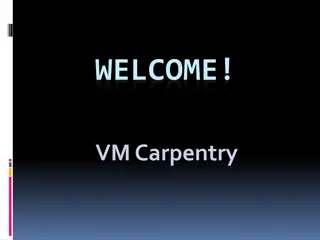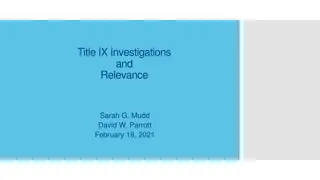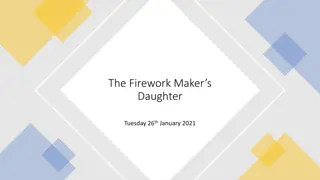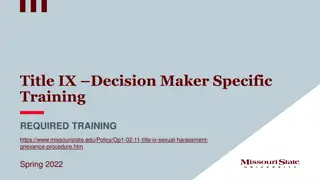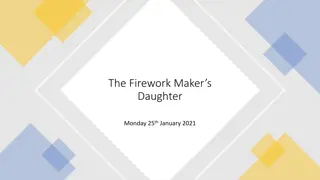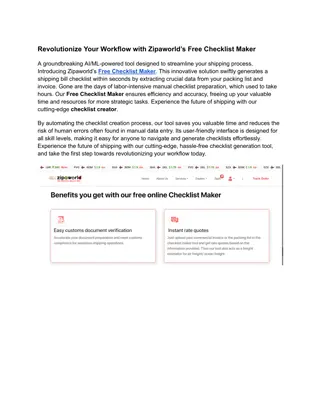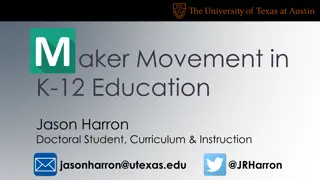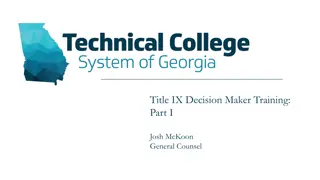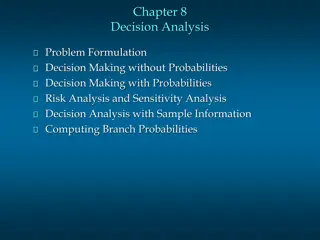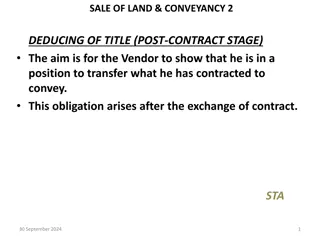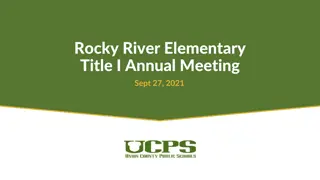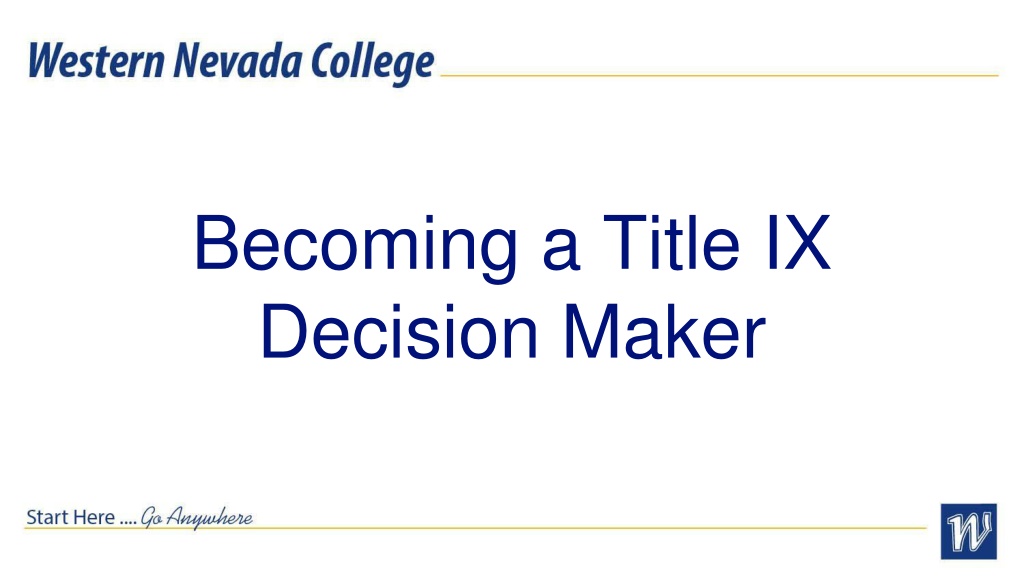
Understanding Title IX Decision-Making Process
Learn about sexual harassment definitions, Title IX grievance process, and the roles of decision-makers as part of becoming knowledgeable in Title IX procedures for addressing complaints effectively.
Download Presentation

Please find below an Image/Link to download the presentation.
The content on the website is provided AS IS for your information and personal use only. It may not be sold, licensed, or shared on other websites without obtaining consent from the author. Download presentation by click this link. If you encounter any issues during the download, it is possible that the publisher has removed the file from their server.
E N D
Presentation Transcript
Becoming a Title IX Decision Maker
Course Objectives Define sexual harassment Understand the jurisdictional limitations of Title IX Understand how a Title IX grievance process is authorized Identify the parties involved in a Title IX complaint Become familiar with WNC s Title IX Grievance Procedure Understand the requirements of the Decision-Maker Understand the roles of a Decision-Maker
Sexual Harassment Defined Title IX utilizes a three-pronged approach, meaning for sexual harassment to occur, one or more of the following must apply: 1. An employee of the recipient conditioning the provision of an aid, benefit, or service of the recipient on an individual s participation in unwelcome sexual conduct; 2. Unwelcome conduct determined by a reasonable person to be so severe, pervasive, and objectively offensive that it effectively denies a person equal access to the recipient s education program or activity; or 3. Sexual assault as defined in 20 U.S.C. 1092(f)(6)(A)(v), dating violence as defined in 34 U.S.C. 12291(a)(10), domestic violence as defined in 34 U.S.C. 12291(a)(8), or stalking as defined in 34 U.S.C.12291(a)(30).
Meaning of Prong 1 An employee of the recipient conditioning the provision of an aid, benefit, or service of the recipient on an individual s participation in unwelcome sexual conduct Quid Pro Quo This for that One incident is sufficient to initiate a Title IX grievance process
Meaning of Prong 2 Unwelcome conduct determined by a reasonable person to be so severe, pervasive, and objectively offensive that it effectively denies a person equal access to the recipient s education program or activity. Third Party - Sexual conduct which is welcomed and reciprocated but creates a hostile environment for others. Sexual Favoritism - Sexual conduct that is welcomed and reciprocated, but results in unfair treatment of others. Sex-Based - Any harassing conduct which is based on gender can constitute sexual harassment. Hostile Environment - Jokes, images, posters, slurs, derogatory comments, etc. that involve sexual content. This behavior is so frequent or serious that it effectively denies a person equal access to the educational program or activity.
Meaning of Prong 3 Sexual assault as defined in 20 U.S.C. 1092(f)(6)(A)(v), dating violence as defined in 34 U.S.C. 122291(a)(10), domestic violence as defined in 34 U.S.C. 12291(a)(8), or stalking as defined in 34 U.S.C. 122291(a)(30). Title IX now considers acts of Sexual Violence to be under the umbrella of Sexual Harassment. One incident is sufficient to initiate a Title IX grievance process
Title IX Jurisdiction For the alleged conduct to be considered within the authority of Title IX it must occur: Within the United States of America If the alleged incident took place outside of the United States, it will be considered a Non-Title IX incident. Within WNC s educational program or activity The alleged act must occur within the scope of a WNC program or sponsored event. For example, the alleged incident occurred during WNC soccer game and it involved two WNC student-athletes. This example would be considered a Title IX incident. For example, the alleged incident took place at a non-WNC affiliated residence between two fellow WNC Students that happen to be roommates. This example would be considered a Non- Title Ix incident because it did not occur within the scope an educational program, activity, or facility.
Title IX Grievance Process Authorization For a Title IX grievance process to be authorized the following must occur: The alleged conduct satisfies one or more of the three pronged requirements listed within Title IX s definition of Sexual Harassment. The alleged conduct occurred within the United States The alleged conduct occurred within WNC educational program or activity. If the alleged incident does not meet the above, then the Title IX Grievance Process is Not Authorized. However, this does NOT mean WNC will take no action. If the Title IX Grievance Process is not authorized, at the discretion of OIE, then the incident may be investigated utilizing the Non-Title IX grievance procedure list in Title 4, Chapter 8, Section 13 of the NSHE Board of Regents Handbook.
Title IX Grievance Procedure Authorized Who you need to know
Parties involved in a Title IX Grievance Complainant means an individual(s) who is alleged to be the victim of conduct that could constitute sexual harassment. Respondent means an individual(s) who has been reported to be the perpetrator of conduct that could constitute sexual harassment. Reporting party means the complainant(s) and respondent(s). Advisor is an individual that accompanies the complaint or respondent to any related meeting or proceeding in order to offer them support. The reporting party chooses their advisor, who may be, but is not required to be, an attorney. The reporting parties can not be limited in whom they choose to be the advisor. Witness means an individual(s) that have or could potentially have information related and/or relevant to the alleged incident.
Facilitators of a Title IX Grievance Procedure Title IX Coordinator Title IX INvestigator Dismissal Appeal Decision-Maker (If applicable) Live-Hearing Decision-Maker Determination Appeal Decision-Maker (If applicable)
The Title IX Grievance Procedure Understanding the Process
Title IX Grievance Process - Simplified Step 10: Related evidence given to reporting parties and advisors Step 1: WNC Notified of Possible Title IX Incident. Step 2: Title IX Coordinator Meets with Possible Complainant. Step 11: Investigative Report Written Step 12: Investigative Report given to appropriate personnel. Step 3: Complaint Filed Step 13: Live-Hearing Conducted Step 4: Investigators send Notification of Investigation Step 14: Decision-Maker completes the written determination of responsibility Step 5: Complainant interviewed by Investigator Step 6: If necessary, complaint dismissed Step 15: If necessary, determination of responsibility appealed Step 7: If necessary, dismissal appealed Step 16: If necessary, sanctions and remedies applied. Step 8: Respondent interviewed by Investigator Step 9: Witnesses interviewed and evidence Collected Step 17: If necessary, Title IX Coordinator follows- up with department to ensure sanctions/remedies applied.
Grievance Process Step 1: WNC Notified of Possible Title IX INcident. WNC Receives notification of a possible Title IX incident by: Grievance Form Received Phone call Email IN person Other
Grievance Process Step 2: Title IX Coordinator Meets with Possible Compliant. Provide an overview of the process. Provide complainant with a Procedural Packet. Procedural Packet Includes but is not limited to : Live-hearing process Grievance Form (if necessary) Decision process Title 4, Chapter 8, Section 13 and Title IX Policy Available resources/supportive measures. Investigation process Appeal process Describe applicable supportive measures.
Grievance Process Step 2 Continued Supportive Measures are non-disciplinary / non-punitive individualized services, given without fee to the reporting parties. These supportive measures are designed to restore or preserve equal access to WNC s education program or activity without burdening either the complainant nor the respondent Supportive measures may include CAPS; EAP; extensions of deadlines; modifications of work or class schedules; security escorts on and off campus; leaves of absences; no contact sanctions given between the reporting parties; etc. The supportive measures are given regardless if a formal complaint has been filed or not. The supportive measures are confidential, to the extent that maintaining confidentiality does not impair the ability of providing the supportive measures. For example, change of work hours would require informing the supervisor of the supportive measure. However, the reasoning / details of the complaint remain confidential.
Grievance Process Step 3: Complaint is filed There are two ways a complaint is filed. The Complainant signs and submits the OIE Grievance Form or the Title IX Coordinator signs the OIE Grievance Form. If either of the above occurs, then the Title IX grievance process MUST begin. The Title IX Coordinator only signs the grievance form in the event the complainant does not want to file the complaint and the Title IX Coordinator believes the Complainant s wishes and is conducted at the discretion of the Title IX Coordinator. If this occurs, then the Title IX Coordinator does not become the Complainant. The new complainant that is listed in the process will be listed as WNC. As previously stated, if the original complainant decides to not file, then they still receive supportive measures.
Grievance Process Step 4: Investigators send Notification of Investigation The Notification of Investigation (NOI) is sent by the Title IX Investigator to both reporting parties simultaneously. The NOI informs the reporting parties that a formal Title IX Grievance Process has been authorized. The NOI must include sufficient details known at the time and with sufficient time to prepare a response before any initial interview. Sufficient details include: The allegations that have been filed that constitute sexual harassment as defined by Title IX Identities of the parties involved in the incident, if known Date and location of alleged incident During the investigation, if allegations are presented that were not listed in the original NOI, then the Title IX Investigator must notify, simultaneously, all reporting parties of the new allegations being investigated.
Grievance Process Step 4 Continued The NOI must also include: A statement that the respondent is presumed not responsible for the alleged conduct and that a determination regarding responsibility is made at the conclusion of the complaint process. Inform the parties that they may have an advisor of their choice, who may be, but is not required to be, an attorney. Inform that the advisor will be apart of the entire process; will receive a copy of all related evidence; and must participate in the Live-hearing process. A statement informing the parties of the prohibition against knowingly making false statement informing the parties ***After the NOI has been sent, at any point moving forward, the Complainant can request to withdraw their complaint.***
Grievance Process Step 5: Complainant interviewed by Investigator During the interview with the complainant, they must have an advisor. If they do not have an advisor, then one will be provided by WNC at no cost. If WNC provides an advisor, then advisor will not be an attorney (as stated in NSHE BOR Handbook, Title 4 - Chapter 8 - Section 13). Investigators obtain incident information and applicable evidence Witness information obtained (if applicable) Evidence received from Complainant
Grievance Process Step 6: If necessary, complaint dismissed There are two forms of dismissals: Discretionary and Mandatory Discretionary: Where a complainant notifies the Title IX Coordinator in writing that the complainant would like to withdraw the formal complaint or any allegations therein. Where the respondent is no longer enrolled or employed by the recipient. Where specific circumstances prevent the recipient from gathering evidence sufficient to reach a determination as to the allegations contained in the formal complaint. i.e. where a complainant refuses to participate in the grievance process (but also has not decided to send written notice stating that the wish to withdraw) Mandatory: Not meeting the Section 106.30 definition of sexual harassment Alleged Incident did not occur in a WNC educational program or activity, or Did not occur within the United States
Grievance Process Step 6 Continued If the complaint is dismissed, then all reporting parties must be notified simultaneously. The dismissal notification must include: State the justifications for dismissing the complaint. Statement informing all reporting parties that a Title IX Dismissal does not prevent WNC from utilizing a Non-Title IX Grievance Procedure as listed in the Board of Regent s Handbook, NSHE Code, or other WNC code of conduct policies. (if a Non-Title IX Grievance Procedure will be used, then the reporting parties are to be notified). Give both the complainant and the respondent an equal opportunity to appeal the dismissal.
Grievance Process Step 7: If necessary, dismissal appealed Per Title 4 - Chapter 8 - Section 13 of the Board of Regents Handbook, any party has five (5) calendar days to appeal the dismissal of the complaint. An appeal can only be filed if it is based on the following: Procedural irregularity that affected the outcome of the matter; New evidence that was not reasonably available at the time the determination regarding responsibility or dismissal was made, that could affect the outcome of the matter; The Title IX Coordinator, investigator(s), or hearing officer(s) had a conflict of interest or bias that affected the outcome of the matter If any appeal has been filed based on the above, then all parties involved must be notified, simultaneously, that an appeal has been filed.
Grievance Process Step 7 Continued: The Decision-Maker for the appeal must be an individual who has not been involved in the Grievance Process at this point. I.E., the Appeal Decision-Maker may NOT be the Title IX Coordinator, Title IX Investigator, or Live-Hearing Decision-Maker. During the appeal process, all parties must have an equal opportunity to submit a written statement in support of, or challenging, the dismissal decision. This written statement must be submitted within five (5) calendar days of the dismissal notice. After the parties have submitted their written statement or the deadline to submit their statement has passed, the Appeal Decision-maker must issue a written decision within five (5) calendar days to the reporting parties, simultaneously, describing the result of the appeal and rationale for the result.
Grievance Process step 8: Respondent interviewed by Investigator During the interview with the respondent, they must have an advisor. If they do not have an advisor, then one will be provided by WNC at no cost. If WNC provides an advisor, then the advisor will not be an attorney (as stated in NSHE BOR Handbook, Title 4 - Chapter 8 - Section 13). Before discussing the allegations/incident information, the Investigators inform the Respondent of the Grievance process. Investigators provide the Respondent with a Procedural Packet The Procedural Packet is the same packet the Complainant received from the Title IX Coordinator Investigators obtain incident information and applicable evidence Witness information obtained (if applicable) Evidence received from Respondent Lastly, the Investigators will request from the respondent, a written response to the allegations. The Respondent will have one (1) calendar week to submit their response.
Grievance Process Step 9: Witnesses interviewed and Evidence Collected The Investigators will obtain statements from witnesses provided by the parties involved and, when applicable, other relevant witnesses that were identified by the Investigators. Additionally, during this step, the investigators will be conducting a diligent search for additional evidence related to the complaint. Evidence include, but not limited to, the following: Emails Texts WNC Security Camera Footage Photos Etc.
Grievance Process Step 10: Related evidence given to reporting parties and advisors Once the statements and evidence have been collected, the investigator must provide all obtained documents to the reporting parties. The reporting parties and their advisors are to receive the statements and evidence simultaneously. The reporting parties and their advisors have ten (10) calendar days to review all related evidence and statements.
Grievance Process Step 11: Investigative Report Written During the ten (10) day review of the evidence, all parties must be given equal opportunity to submit statements either supporting or questioning the evidence. If statements were submitted to the Investigators, then the Investigators will take these statements into consideration. After the parties have submitted their statements or the ten (10) calendar days have past, the investigator will write the Investigative Report. The Investigate Report fairly summarizes all statements; summarizes all relevant evidence; and provides a chronology of the events that occurred during the investigation.
Grievance Process Step 12: Investigative Report given to appropriate personnel. Once the Investigative Report has been completed, the Investigators will provide the report to the reporting parties and their advisors for another ten (10) day review. All parties must be given equal opportunity to submit statements either supporting or questioning the Investigative Report. If statements were submitted, then the Investigators will take these statements into consideration. After the parties have submitted their statements or the ten (10) calendar days have past, the Investigative Report will be given to the Title IX Coordinator. It is the responsibility of the Title IX Coordinator to provide the Investigative Report to the Live-Hearing Decision-maker.
Grievance Process Step 13: Live-Hearing Conducted Once the Live-Hearing Decision-Maker is in possession of the Investigative Report, they will conduct the live- hearing. The Live-hearing must include a cross-examination of the evidence, witness(es), and the statements obtained during the investigation. The cross-examination is conducted by the party s advisor. At NO time will the reporting parties themselves directly question the other. The cross-examination must be conducted directly, orally, and in real time. Additionally, the live-hearing may be conducted with all parties physically present in the same locations or virtually through the assistance of technology. If the live-hearing is held virtually, then the technology used must allow the live-hearing to still be held in real time. Additionally, all involved in the Live-Hearing must see and hear each other, and all witnesses. The Live-Hearing must either be transcribed or recorded with the use of audio/visual technology. The transcript or recording will be provided to the reporting parties and their advisors for the review.
Grievance Process Step 14: Decision-Maker completes the written determination of responsibility At the conclusion of the Live-Hearing, it is the responsibility of the Live-Hearing Decision-Maker to complete the written determination of responsibility. The written determination of responsibility must be issued within fourteen (14) calendar days. The written determination of responsibility informs the reporting parties of the outcome of the Grievance Procedure. i.e., is the respondent, responsible or not responsible for the alleged incident outlined in the filed complaint. The Decision-Maker must submit the written determination of responsibility to the Title IX Coordinator, the reporting parties, and the advisors simultaneously.
Grievance Process Step 15: If necessary, determination of responsibility appealed Per Title 4 - Chapter 8 - Section 13 of the Board of Regents Handbook, any party has five (5) calendar days to appeal the dismissal of the complaint. An appeal can only be filed if it is based on the following: Procedural irregularity that affected the outcome of the matter; New evidence that was not reasonably available at the time the determination regarding responsibility or dismissal was made, that could affect the outcome of the matter; The Title IX Coordinator, investigator(s), or hearing officer(s) had a conflict of interest or bias that affected the outcome of the matter If any appeal has been filed based on the above, then all parties involved must be notified, simultaneously, that an appeal has been filed.
Grievance Process Step 15 Continued: The Decision-Maker for this appeal must be an individual who has not been involved in the Grievance Process at this point. I.E., the Determination Appeal Decision-Maker may NOT be the Title IX Coordinator, Title IX Investigator, Dismissal Appeal Decision-Maker, or Live-Hearing Decision-Maker. During the appeal process, all parties must have an equal opportunity to submit a written statement in support of, or challenging, the dismissal decision. This written statement must be submitted within five (5) calendar days of the determination notice. After the parties have submitted their written statement or the deadline to submit their statement has passed, the Appeal Decision-Maker must issue a written decision within five (5) calendar days to the reporting parties, simultaneously, describing the result of the appeal and rationale for the result.
Grievance Process Step 16: If necessary, sanctions and remedies applied. The written determination of responsibility is considered final when: The date to file an appeal has expired The appeal process is completed Only when the written determination of responsibility is finalized may sanctions and/or remedies be applied. If there are sanctions, then the Decision-Maker will notify the appropriate personnel of the sanctions to be enforced. I.e., if the student is determined responsible, then student conduct will be notified. If employee, then their department/supervisor will be notified. The Decision-Maker will not provide all information regarding the complaint. ONLY the applicable sanctions may be given. It is the responsibility of the Title IX Coordinator to apply any remedies, if applicable.
Grievance Process Step 17: If necessary, Title IX Coordinator follows-up with department to ensure sanctions/remedies applied It is the responsibility of the Title IX Coordinator to ensure all remedies and/or sanctions have been issued. Once all remedies and/or sanctions have been applied, the Grievance Procedure ends, and the case is closed.
The Decision-Maker The Requirements
The Requirements of the Decision-Maker In order to become a Decision-Maker you must: Understand relevancy Understand how to weigh the evidence Serve Impartially Recognize bias and stereotypes Understand where the burden of proof rests
Relevance Relevant means a question or evidence having any tendency to make the existence of any fact that is of consequence to the determination of the action more or less probable than it would be without the question or evidence (Title 4 - Chapter 8 - Section - 13). The Decision-Maker must consider the relevancy of questions and evidence, both inculpatory and exculpatory Inculpatory: causing blame; to be imputed; to incriminate. Evidence favorable to the complainant. Exculpatory: anything that clears someone or something of guilt. Evidence favorable to the respondent.
Types and Weight of Evidence Direct Corroborating Supports the case exactly Evidence that supports other evidence Video surveillance showing the respondent s actions There was a witness present during the incident and their statement supports either the complainant or respondent. Legally obtained / admissible audio recordings that capture the sexual remarks Emails / texts / photos / etc. that supports either the complainant or respondent. Alleged incident witnessed by multiple others and all give same statement 2nd best evidence, good weight given when determining responsibility Respondent admits to conducting the alleged behavior/act Best Evidence, great weight given when determining responsibility
Types and Weight of Evidence Circumstantial Character Evidence can be used to INFER but not PROVE a conclusion. Opposite of Direct. Not useful Alleged patterned evidence. I.e., He/she good person / bad apple The respondent has allegedly conducted the same behavior in the past Controversial Demeanor during interview / live- hearing Just because an individual has done it in the past, does not prove they did the behavior this time Hearsay, He/she is creepy, so they definitely did it She said he did this, he said he did not. (no corroborating evidence) In Title IX Grievance Procedure, determinations are NOT to be made based on inference. No weight given No weight given
Being Impartial There can be no conflicts of interest. If there is a conflict of interest, then one can not be the Decision- Maker. The Decision-Maker can not be for or against complainants or respondents generally or an individual complainant or respondent. If a complainant is given an opportunity, then the respondent must be given the same opportunity and vice versa. The Decision-Maker will avoid prejudgment of the facts at issue. The Decision-Maker will treat all parties the same regardless of their status as a complainant, respondent, or witness. The Decision-Maker must keep in mind that the respondent is not responsible for the alleged conduct until a determination regarding responsibility is made at the conclusion of the complaint process. The Decision-Maker will be free of bias and avoid making decisions based on stereotypes.
Bias and Stereotypes A Decision-Maker must be free of bias and stereotypes. A bias is a feeling or preference that interferes with an impartial judgment for or against; usually considered to be unfair. A stereotype is a widely held, but fixed and oversimplified image or idea of a particular group of people, lacking any individuality. Examples of biases and sex stereotypes to refrain from: The complainant is automatically right because they re the victim. Determination of responsibility will only be made at the END of Grievance Procedure and must be based upon the preponderance of the evidence. Only men can sexually harass others One s gender, sex, sexual orientation, etc. must NOT be used against them when determining responsibility.
Bias and Stereotypes Conscious or Explicit: In the case of explicit or conscious bias, the person is very clear about his or her feelings and attitudes, and related behaviors are conducted with intent. This type of bias is processed neurologically at a conscious level as declarative, semantic memory, and in words. Conscious bias in its extreme is characterized by overt negative behavior that can be expressed through physical and verbal harassment or through more subtle means such as exclusion. Unconscious or Implicit: Implicit or unconscious bias operates outside of the person s awareness. It can be in direct contradiction to a person s beliefs and values. Implicit bias is dangerous in that it automatically seeps into a person s affect or behavior and is outside of the full awareness of that individual. Implicit bias can interfere with decision-making, and professional relationships such that the goals that are established are compromised. These bises are associated with stereotyping.
Overcoming Bias and Stereotypes To overcome biases, we must: First, recognize that we have them. Be honest with yourself and admit to having the biases Second, understand why we have them. Was it taught by your environment or did a negative experience cause the bias? Third, make a conscious effort not to let them control our decisions. Take control of the bias! Understand the cause and work out the solution to let it go!
Burden of Proof The burden rests on WNC The Burden of proof and the burden of gathering evidence sufficient to reach a determination regarding responsibility rests on WNC and not on the reporting parties. When making a determination, the evidentiary standard of Preponderance is to be used. Preponderance of the evidence means the evidence establishes that it is more likely than not that the prohibited conduct occurred (I.e., 50% plus a feather).
The Decision-Maker Understanding your role
The Role of the Decision Maker As a Decision-Maker you will either facilitate an Appeal or the Live-Hearing. Each complaint is unique. There could be up to three Decision-Makers for one complaint: Dismissal appeal Decision-Maker Live-Hearing Decision-Maker Determination Appeal Decision-Maker Having a separate Decision-Maker each step ensures that the decision(s) was determined based on fact, was made by exercising independent judgment, and was free from bias.
Appeal Decision-Maker There is only ONE appeal process, regardless of the type (dismissal or determination). As stated, an appeal must be based on: Procedural irregularity that affected the outcome of the matter; New evidence that was not reasonably available at the time the determination regarding responsibility or dismissal was made, that could affect the outcome of the matter; The Title IX Coordinator, investigator(s), or hearing officer(s) had a conflict of interest or bias that affected the outcome of the matter It is your responsibility as the Appeal Decision-Maker to review the appeal and issue a written decision.
The Appeal Process Once the reporting parties have been notified of either the dismissal or of the determination of responsibility, they have five (5) calendar days to file an appeal. If an appeal has been filed, then the parties involved, and their advisors, must be notified, simultaneously. When all have been notified, the parties have five (5) calendar days to submit a statement in either support of, or challenging, either the dismissal or determination.






